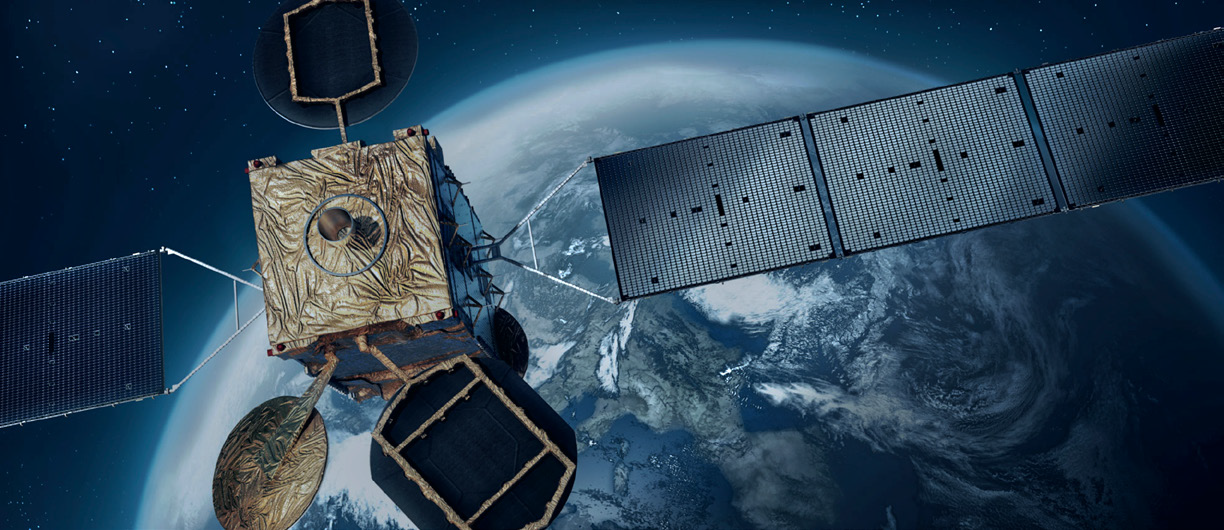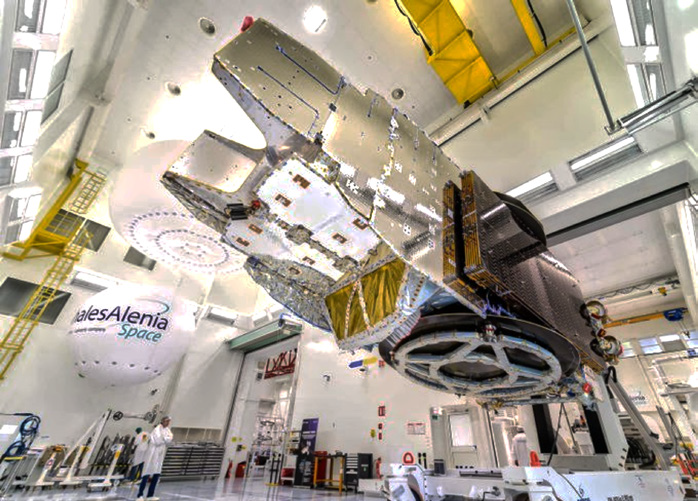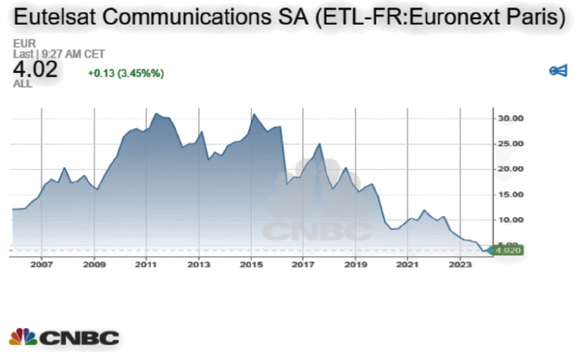Eutelsat is having quite a tough time. Ratings agency Fitch in December of last year downgraded the company’s debt to ‘junk bond’ levels. Various investment banks have issued pessimistic forecasts on the company’s prospects.

Artistic rendition of handling today’s satellite challenges. Eutelsat Konnect on-orbit, courtesy of the company.
Meanwhile, Eutelsat is, itself, digesting its merger with OneWeb and looking to achieve significant synergies as the company migrates from a (mostly) Video- based business to one that is much more focussed on Telco activity. Investors have suffered, dividends suspended, and those remaining involved are looking forward to growth, in particular from the OneWeb addition.

Giuliano Berretta
Giuliano Berretta was the DG and CEO (as well as executive Chairman) in the period 1998 to 2011. During his time, he took Eutelsat from a business owned by Europe’s telcos to privatized status and a Paris bourse listing.
In our conversation, he explained that, in recent years, traditional satellite operators have overseen the dramatic growth of a new generation of terrestrial networks, based on the full IP paradigm and bandwidth and performance that cannot be matched by geostationary satellites, including the VHTS (very high throughput satellite) craft, such as Eutelsat Konnect.
Berretta says that Eutelsat Konnect could now be considered the last chapter for Eutelsat in the framework of VHTS history which started with Eutelsat’s KaSat [launched in 2010, and now owned by Viasat] and which was the first IP network-oriented satellite system in Europe to deliver IP connectivity from on-orbit satellites.
He admits that changes in the Video market and, in general, the matching revenue decline for satellite operators, has also been a serious problem for Eutelsat, considering that Europe has a very pervasive and high-performance IP network architecture and which has badly penalized Eutelsat in the short terms “and more Eutelsat than SES.”

Eutelsat Konnect during manufacturing at Thales Alenia Space.
“Eutelsat has always operated with an eye on Western Europe and looking ahead toward Eastern countries in Europe and Asia, as well as Africa and Latin America. It is well known that the first booming of the Video market was represented by the sudden expansion to Eastern European countries which were coming out from 70 years of Communist regimes,” Giuliano said.
He added that recent geo-political changes and international politics are not necessarily good news for exploiting new markets. “At an international level the USA and China have decided to start a roadmap to drive competition, the BRICS (Brazil, Russia, India, China and South Africa) are changing and are including countries which have various strategic alliances.”
Recently, the BRICS gathered in Johannesburg for the 15th BRICS Summit, where they announced the accession of six new members from Asia, Africa, and Latin America. An additional 22 countries have formally requested to join the bloc, which has now been renamed BRICS+. Additionally, more than 40 countries have expressed informal, participation interest the organization. These members now represent nearly half of the world’s population.
“All these countries need modern and powerful broadband networks, with connectivity the main infrastructure necessary to grow. BRICS are characterized by large territories, billions of citizens but where connectivity is a fundamental issue and not only in the urban areas. The roadmap to design and achieve these infrastructures can be a major drawback for their economic and social growth.
“For the past 10 years the satellite industry has moved towards LEO-based mega-constellations. They have become possible because of miniaturization and standardization of the orbital devices as well as the possibility of using quasi- terrestrial electronics on-board and the presence of a new generation of launches which have drastically reduced the cost of launches,” suggested Guiuliano.
“Companies such as OneWeb, SpaceX, LeoSat, and Telesat had all envisioned delivering broadband via hundreds, if not thousands, of LEO satellites. The mega-constellation movement had begun, and LEO was the talk among industry players around the world. Over the next five years, more than 4,150 LEO birds are expected to be launched overall. NSR forecasts around 78 Tb/s of usable capacity to be brought to the market by the major LEO constellations,” he stated.
He compares and contrasts these developments with those at Eutelsat. “The Eutelsat approach is very interesting and is based on a deep integration with the on-going networks based on the new 5G 3GPP network architecture. The backbone of this strategy will allow Eutelsat to cooperate with all the Telecom operators worldwide.”
He noted that the Eutelsat move to acquire OneWeb was a necessary step to move into the LEO space in a speedy timeframe and to challenge the presence of Starlink, considering that BRICS will not necessarily favor a product that’s owned by a single, American, private owner. Eutelsat has been always open to cooperation and integration with terrestrial resources and has always enjoyed a long and fruitful heritage with European telecom operators.
Berretta said he believes Eutelsat is well placed to develop relationships with OTT operators in these BRICS countries, especially with OneWeb. “The Eutelsat approach to be part of the 5G architecture is, in my opinion, a winning move.
It has to be remembered that the revolutionary aspect of a 5G network is not simply the access but the network architectural management.

“On the access side very broad bandwidth introducing new access standards and new technologies such as massive MIMO (Multiple Input Multiple Output) and smart antennas, which can be considered a network evolution and a very real revolution. On the network management side integrating resources and optimizing them via the introduction of disrupting functionalities such as Orchestration and network slicing.
“Eutelsat has a unique opportunity, being the only satellite operator having the availability of a LEO constellation to integrate satellite with terrestrial infrastructures according to the new 5G vision as network of networks. An additional and important aspect is that, within this scenario, VHTS satellites are not unused but become essential elements, where extremely low latency is not going to be the main issue, for managing video-streaming and CDN networks integrated in the same 5G network architecture,” the former Eutelsat CEO said.
“Thanks to a modular and growing approach Eutelsat can take the advantage of reusing the last generation of GEO-VHTS which have been an enormous effort in term of system configuration, technology, and performance for telecommunications satellites. They represent the concrete possibility to deliver IP broadband connectivity to wide geographical regions with prices comparable and for rural and suburban areas even lower than the equivalent terrestrial connectivity technology,” Berretta explained.
OneWeb’s mega-constellation — properly integrated with VHTS Geostationary satellites — represents a valid solution for integrating satellite networks into the overall IP terrestrial system within the 5G network architecture.
However, he added that LEO and GEO’s VHTS need investment on ground architecture to take advantage of satellite connectivity. In particular, the VHTS systems need consistent Hub and terrestrial layers.
“Indeed, the terrestrial network is the key element for the satellite system to operate, allowing the interconnection among all the access point to the satellite system itself: The interconnected hubs give the possibility of frequency reuse, the overall coverage interconnectivity and the possibility to be fully integrated with the terrestrial telecom infrastructure via suitable routing points and network orchestration functionality.
“The similarities between LEO and GEO-VHTS systems are not limited only to the functionality but also to the geography and the coverage needs, i.e., the terrestrial infrastructures dedicated to guarantee the satellite access use different antenna technologies and numbers (LEO need more than one antenna for each hub to allow satellite handover and service continuity) but the most of them could be co-located for LEO and GEO systems with the clear fundamental advantage to optimize all the installation, maintenance and operative costs. Another additional advantage in the proper selection of the hub geographical positions is the reduction of the staff necessary to operate,” he added.
The user shell in the new concept of both VHTS and LEO constellations can be either direct user access points or part of the backhaul network connected with the “last mile” user section, for instance, connected with the network RANs (Radio Access Network) of the Mobile Network, WiFi access points or fixed access networks.
“Therefore,” he said, “from a system point of view they have the same utilization and if needed they can be combined to offer performance as required based on the desired bit rate, latency, robustness, and resilience characteristics, managed by the proper Network Orchestration and slicing capability.”
The typical dimension of a GEO-VHTS coverage spot is on the order of a few hundreds of kilometers. This area is not so far from the field of view of a LEO satellite (ranging from a few hundreds to a couple of thousands), where each LEO satellite is using some tenths of spots inside its field of view to serve the customer distributed in the area. Typically, it is necessary to associate Forwards and Return links of the Hubs with a few Users coverage spots to make feasible the Frequency reuse and allowing the system a very broadband capability.
“From a system point of view LEO is requiring a larger number of hubs but, from a functional point of view, to guarantee the whole network connectivity all the hubs shall be connected via a number of optical broadband rings. Therefore, the two network architectures are similar and both need the fundamental presence of the terrestrial broadband IP network to guarantee the full accessibility to and from the satellite shell.”
Eutelsat, Berretta said, is in an excellent position to combine these two satellite technologies, and linking with terrestrial networks. “The potentialities of Eutelsat shall be extended from the present and expected reduction of the Video market to the business opportunities given by the integration in a unique architecture of different network technologies as defined by 5G and optimizing the orchestration of the overall network integrating LEO and GEO with the terrestrial network.”

Chris Forrester
Author Chris Forrester is a Senior Columnist and Contributor for SatNews Publishers and is a well-known broadcasting journalist and industry consultant. He reports on all aspects of broadcasting with special emphasis on content, the business of television and emerging applications.


